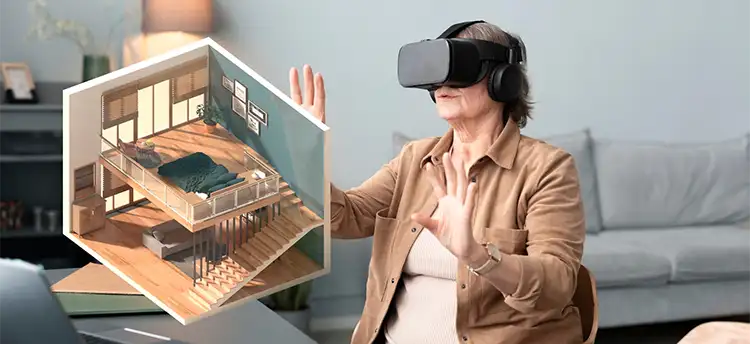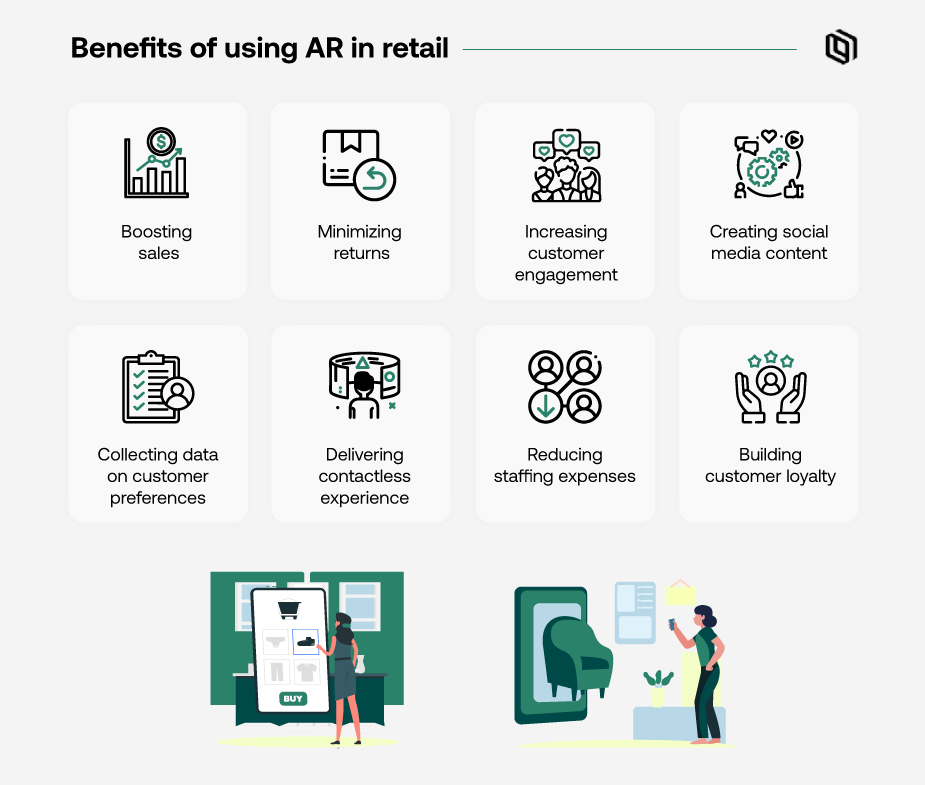
In today’s digital age, businesses are constantly seeking innovative ways to enhance customer engagement and reduce returns and refunds. Enter augmented reality (AR), a groundbreaking technology that is revolutionizing the way customers interact with products. In this article, we will explore how AR drives customer engagement and effectively reduces returns and refunds, bringing a new level of satisfaction to both businesses and consumers.
Augmented reality is an immersive technology that superimposes virtual elements onto the real world, enhancing the user’s perception and experience. By leveraging AR, businesses can offer their customers a unique and interactive way to explore and engage with their products. Imagine being able to try on clothes virtually, visualize furniture in your living room, or even test drive a car without stepping foot into a dealership. AR brings these experiences to life, allowing customers to make informed purchasing decisions and deeply connect with the products they are interested in.
Not only does AR enhance customer engagement, but it also plays a crucial role in reducing returns and refunds. One of the main reasons for returns and refunds is the discrepancy between customers’ expectations and the actual product received. With AR, customers can get a realistic preview of the product before making a purchase, eliminating any surprises or disappointments. By virtually trying on clothes or visualizing how furniture fits into their space, customers can accurately assess whether the product meets their needs and preferences. This leads to more satisfied customers who are less likely to return or refund their purchases, ultimately benefiting both businesses and consumers alike.

In conclusion, augmented reality is a game-changer when it comes to driving customer engagement and reducing returns and refunds. By offering immersive and interactive experiences, businesses can captivate their audience and build a stronger connection with their customers. Moreover, AR allows customers to make informed purchasing decisions, resulting in a decrease in returns and refunds. As technology continues to evolve, it is clear that augmented reality is here to stay and will continue to shape the way we engage with products in the future.
Augmented Reality (AR) is revolutionizing the way customers engage with products. By overlaying digital information onto the real world, AR enhances the shopping experience, leading to increased customer engagement. With AR, customers can visualize products in their own environment, virtually try them on, and even see how they would look or function before making a purchase. This immersive experience reduces the likelihood of returns and refunds, as customers have a better understanding of the product’s features and suitability. Embracing AR technology can significantly enhance customer satisfaction and reduce the hassle of returns and refunds.
How an Augmented Reality (AR) Drives Customer Engagement and Reduces Returns and Refunds?
Augmented Reality (AR) technology has revolutionized the way businesses interact with their customers. By integrating virtual elements into the real world, AR provides an immersive and interactive experience that drives customer engagement and reduces returns and refunds. In this article, we will explore how AR is transforming the retail industry and why businesses should consider implementing this innovative technology.
The Power of AR in Customer Engagement
AR enhances the shopping experience by allowing customers to visualize products in a virtual environment before making a purchase. This technology bridges the gap between online and offline shopping, providing customers with a realistic preview of products and empowering them to make more informed decisions. By enabling customers to virtually try on clothing, test out furniture in their own space, or see how cosmetics look on their face, AR creates a personalized and interactive shopping experience that increases customer engagement.
AR also enhances customer engagement by immersing them in branded experiences. For example, beauty brands can create AR filters that allow customers to virtually try on makeup looks and share them on social media. This not only drives brand awareness but also encourages customers to engage with the brand in a fun and interactive way. By leveraging AR, businesses can capture the attention of consumers and create memorable experiences that foster long-term customer loyalty.
The Role of AR in Reducing Returns and Refunds
Returns and refunds are a significant challenge for businesses, costing them time, money, and resources. However, AR has the potential to minimize these issues by providing customers with a more accurate representation of products. When customers can virtually try on clothing or visualize furniture in their own space, they can make more informed purchasing decisions, reducing the likelihood of returns due to size or fit issues.
AR also helps customers overcome the limitations of online shopping by allowing them to see products from different angles and in various environments. This eliminates the guesswork and uncertainty associated with online purchases, leading to higher customer satisfaction and fewer returns. By leveraging AR technology, businesses can provide customers with a realistic and immersive shopping experience that minimizes the need for returns and refunds.

In summary, augmented reality is a game-changer for businesses looking to enhance customer engagement and reduce returns and refunds. By leveraging AR technology, businesses can provide customers with an interactive and personalized shopping experience that drives engagement and fosters brand loyalty. Additionally, AR enables customers to make more informed purchasing decisions, minimizing the need for returns and refunds. As AR continues to evolve, businesses should consider integrating this innovative technology into their strategies to stay ahead of the competition and meet the ever-changing demands of today’s consumers.
Key Takeaways
- Augmented Reality (AR) enhances customer engagement by providing immersive and interactive experiences.
- AR allows customers to visualize products in their own space, helping them make informed purchasing decisions.
- By reducing ambiguity, AR minimizes the chances of customers returning or refunding products due to dissatisfaction.
- AR-driven customer engagement leads to increased brand loyalty and repeat purchases.
- AR technology is accessible and user-friendly, making it suitable for customers of all ages, including 13-year-old kids.
Frequently Asked Questions
1. How can augmented reality drive customer engagement?
Augmented reality (AR) has the power to revolutionize customer engagement by providing immersive and interactive experiences. By overlaying digital information onto the real world, AR allows customers to visualize products in their own environment, enhancing their understanding and connection with the products. This level of engagement can lead to increased customer satisfaction and loyalty.
AR also enables customers to interact with products in a unique way. For example, they can try on virtual clothing, test out furniture placement, or even virtually walk through a property before making a purchase. This hands-on experience not only captivates customers but also helps them make more informed decisions, reducing the chances of returns or refunds.
2. Can augmented reality reduce returns and refunds?
Yes, augmented reality has the potential to significantly reduce returns and refunds. One of the main reasons customers return products is because they are not exactly what they expected. With AR, customers can visualize and interact with products before buying, giving them a better understanding of the product’s features, size, and overall suitability.
By virtually trying on or testing out products, customers can better evaluate whether the product meets their needs and preferences. This reduces the likelihood of purchasing items that are not a good fit, leading to fewer returns and refunds. AR also reduces the risk of damage during shipping, as customers can assess the product’s dimensions and compatibility with their space before making a purchase.
3. How does augmented reality enhance customer satisfaction?
Augmented reality enhances customer satisfaction by bridging the gap between online shopping and the in-store experience. It allows customers to virtually interact with products, providing a more immersive and personalized shopping experience. This increased engagement leads to higher customer satisfaction as they feel more connected to the products they are considering.
AR also improves customer satisfaction by reducing uncertainty and buyer’s remorse. By visualizing products in their own environment, customers can better assess how the product will fit into their lives. This minimizes the chances of disappointment upon delivery and increases overall satisfaction with the purchase.
4. What industries can benefit from augmented reality in reducing returns and refunds?

Various industries can benefit from augmented reality in reducing returns and refunds. The fashion industry, for example, can leverage AR to enable customers to virtually try on clothing and accessories, reducing the likelihood of ill-fitting purchases. The home decor and furniture industry can use AR to allow customers to visualize how products will look in their homes, reducing the chances of mismatched styles or sizes.
Additionally, industries such as automotive, real estate, and electronics can benefit from AR by providing virtual simulations and visualizations. Customers can explore car interiors, walk through virtual properties, or see how electronic devices will fit into their daily lives, reducing the chances of dissatisfaction and subsequent returns or refunds.
5. What are the potential challenges in implementing augmented reality for reducing returns and refunds?
While augmented reality holds great promise in reducing returns and refunds, there are some challenges to consider. One challenge is the need for robust and user-friendly AR technology. The experience must be seamless and intuitive for customers to fully benefit from it. This requires investment in hardware, software, and user interface design.
Another challenge is the need for accurate product representations in augmented reality. The digital overlays must accurately reflect the real product in terms of color, size, and texture. Any discrepancies between the virtual representation and the actual product may lead to disappointment and potential returns or refunds. Ensuring accurate and high-quality product visualization is crucial for the success of AR in reducing returns and refunds.
Final Thoughts: Augmented Reality (AR) – A Game Changer for Customer Engagement and Returns Reduction
Augmented Reality (AR) has emerged as a powerful tool for businesses to enhance customer engagement and reduce returns and refunds. By integrating virtual elements into the real world, AR provides a unique and immersive experience that captivates consumers and drives their purchasing decisions. Through the use of AR, customers can visualize products in their own environment, try them on virtually, and gain a better understanding of their features and functionalities. This not only creates a memorable and interactive shopping experience but also reduces the likelihood of returns and refunds.
One of the key benefits of AR in driving customer engagement is its ability to bridge the gap between online and offline shopping. With AR, customers can virtually “try before they buy,” eliminating the uncertainty that comes with online purchases. By being able to visualize how a product will look or fit in their own space, customers feel more confident in their purchasing decisions. This increased confidence leads to higher customer satisfaction and loyalty, ultimately reducing returns and refunds.
Moreover, AR enables businesses to showcase their products in a more dynamic and personalized way. By allowing customers to interact with virtual objects and explore different options, AR creates a sense of ownership and connection. This emotional connection not only increases customer engagement but also reduces the likelihood of returns, as customers feel more invested in their chosen products.
In conclusion, Augmented Reality (AR) has revolutionized the way businesses engage with their customers and tackle the issue of returns and refunds. By providing immersive and interactive experiences, AR drives customer engagement and enables them to make more informed purchasing decisions. As businesses continue to embrace this technology, we can expect to see a significant reduction in returns and refunds, leading to higher customer satisfaction and increased profitability. So, leverage the power of AR to transform your customer experience and reap the rewards it brings.
